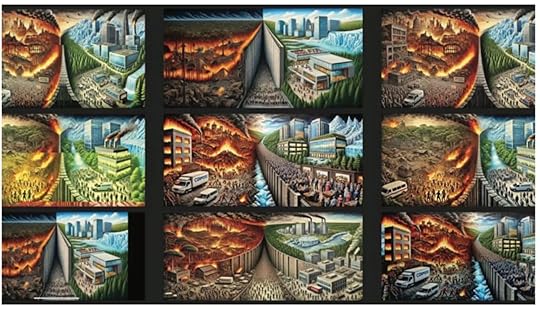Forces of Nature

Quickly, before we get into the real horror, two upcoming events…
I’ll be doing a brief introduction for a screening of George A. Romero’s Dawn of the Dead, presented by DSA-LA’s Hollywood Labor Committee. It’s at 7pm PST on October 29 at Whammy! Analog Media in Silverlake. Find more info here.
I’m also presenting a paper titled “From Modern Materialism to Popular Modernism: (Re-)constructing a communist methodology of aesthetics” at Historical Materialism London, on November 6, 7pm GMT. More info about the conference here.
California Governor Gavin Newsom thinks that the arrest of Jonathan Rinderknecht will bring “closure” to those who lost their homes or were otherwise affected by the Los Angeles fires ten months ago. Maybe there will be for some, but I doubt it. Not when thousands are still mired in the financial quicksand of rebuilding, fighting with insurance companies who either stopped coverage or simply won’t pay up. Not when the hills of the Palisades and Altadena are still pockmarked with ruins.
Rinderknecht is an easy scapegoat, a way to personalize the disaster and grief, someone to easily blame, a convenient conduit for grief and rage. Evidence released – namely data from his phone – puts him where the Palisades Fire started… a full week before the blaze began. There, he looks to have started the Lachman Fire, a small, relatively insignificant fire that was quickly put out by LA firefighters. Or so it seemed. Embers smoldered there for a week in an underground root system. All it needed was a strong Santa Ana wind to pick it up. Which it did.
I have a long essay on the fires and their fallout in the upcoming issue of Salvage. Here’s a bit of what I’ve written there:
In ‘The Case for Letting Malibu Burn,’ [Mike] Davis writes of the ‘non-linear’ nature of the region’s fire risks. The Big One was never going to have only one cause, particularly as climate change throws predictable weather patterns out of whack. Several wetter-than-normal winters have allowed scrub brush and other undergrowth to flourish in recent years. Combine this with summers that get hotter and drier every year, and an unseasonably dry opening to the 2024-25 winter, and you’ve got ample fuel for something unprecedented.
Now add in the windstorms. The Santa Anas are an autumnal occurrence normally. High atmospheric pressures build up in the Great Basin of Utah and Nevada, then sweep down to the low-pressure coast. Having the Santa Anas show up in the first week of 2025 is further testament to the consequences of climate imbalance. Drastically different atmospheric pressures collide, and the gusts are pushed through the wind silos of the Santa Monica mountains. Trees and power lines are brought down. Sparks fly further and quicker.
No, Malibu and Pacific Palisades should probably never have existed, at least as densely as they do now. It is a steep price to pay for a nice view. But extreme conditions take their toll well beyond the usual fire zones. Altadena, a multiracial town on the eastern edge of LA, one of the few places in California where African Americans could own a home during the height of redlining, was devastated by the Eaton Fire. By some estimates, half of all Black homes burned down.
Climate breakdown, uneven and unequal urban development; these are all far greater problems. Obviously, they will not be addressed by simply putting Rinderknecht behind bars. Which isn’t to dismiss the role he apparently played. Who knows what will emerge in the coming weeks and months, and one should always take any media coverage (mainstream or otherwise) with a grain of salt nowadays. But the impression one gets of him so far is of someone quite troubled, though no more or less troubled than most people.
Prosecutors and investigators have said Rinderknecht was driving for Uber in the Palisades when he set the fire on New Year’s Eve. The passengers described him as “agitated,” though anyone who has had to work on New Year’s, particularly driving around drunk rich kids, can probably explain that agitation. The building manager at his apartment said he might have also worked as a restaurant server in Hollywood.
Neighbors and acquaintances describe him as two different people: on one end very normal, on the other someone volatile and disaffected. He was probably both. Nothing is more normal in this era than being disaffected, generally unmoored, isolated, without direction or support. Naturally, plenty of people manage to eke through the social disintegration without setting catastrophic fires.
There’s also, however, reason to believe he never anticipated it growing into the raging inferno that decimated the Palisades. Should he have? Nobody anticipated the Santa Anas to pick up the way they did, though at the same time the fire zone signs in Los Angeles are up year-round for a reason. It’s entirely possible this is a person with a level of dissociation that has left his sense of consequence completely distorted. If so, then we can only return to questions of what shaped him into this.
If the future is lucky enough to have archeologists of some kind, then they will be a jarring combination of spoiled and frustrated. Should the records of the algorithm survive in some legible way, they’ll be able to map our cultures to an unprecedented level of detail. The twists and turns of those maps, however, will be baffling, possibly to the point of indecipherability. Exploring the endless reams of queries, fantasies and scenarios stored in the memories of ChatGPT one of them may come across this prompt, and the images it generated:
“In the middle [of the painting], hundreds of thousands of people in poverty are trying to get past a gigantic gate with a big dollar sign on it.
“On the other side of the gate and the entire wall is a conglomerate of the richest people.
“They are chilling, watching the world burn down, and watching the people struggle. They are laughing, enjoying themselves, and dancing.”
It will likely be difficult for any archeologist to tell if these words are an accurate depiction of the world that produced the LA fires, or the digital ravings of someone deeply unwell. They are, in fact, both.
Header is images prompted by Jonathan Rinderknecht on ChatGPT, sourced through the BBC. I do not condone using AI to generate “original” images.
To Whom It May Concern... is a reader-supported publication. To receive new posts and support my work, consider becoming a free or paid subscriber.



